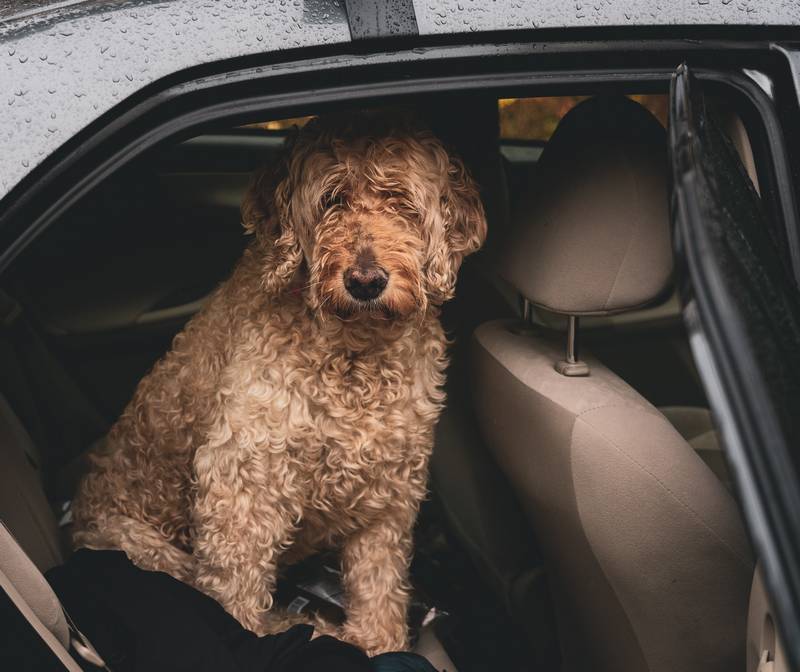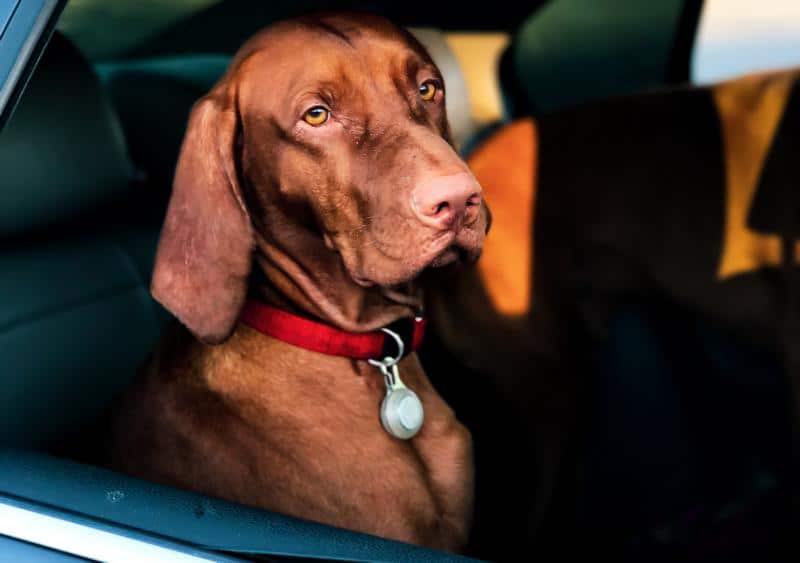Dog Chewed Seat Belt: Repair + Stop the Behavior! [5 Steps]
If your dog chewed your seat belt, we have solutions for you in this article. We’ll show you how to stop your dog from chewing seat belts and give you tips on how to repair a chewed seat belt.
You’ll also learn why dogs chew seat belts, because understanding this behavior can help you prevent it from happening again. Plus, we’ll discuss the specific issue of puppies chewing on seat belts, which can be a common issue with younger dogs. Keep reading below!
Stop Dog Chewing Seat Belts

Stopping a dog from chewing seat belts primarily involves providing alternative chew toys, applying deterrent sprays, ensuring regular exercise, and using positive reinforcement training. Consistent implementation of these methods can curtail the destructive behavior and protect your vehicle’s interior.
- Provide Chew Toys: Dogs chew on seat belts often out of boredom or anxiety. Providing a selection of safe, dog-friendly chew toys in the car can divert your dog’s attention away from the seat belts.
- Use Deterrent Sprays: There are safe, non-toxic sprays available that can deter a dog from chewing. Spray a small amount on the seat belts before a car ride. The unpleasant taste should discourage your dog from continuing to chew. Remember, though, that this doesn’t address the underlying cause.
- Ensure Regular Exercise: Regular exercise helps to burn off your dog’s excess energy, making them less likely to resort to destructive behaviors such as chewing. Before a car ride, try taking your dog for a walk or playing fetch.
- Positive Reinforcement Training: Train your dog to associate the car and seat belts with positive experiences. Whenever your dog ignores the seat belts or shows good behavior in the car, reward them with treats and praise.
- Address Underlying Issues: If your dog’s seat belt chewing is persistent and severe, you likely have an underlying behavioral issue to deal with. Continue reading and we’ll explain how to handle things by getting down to what’s really driving your dog’s problem.
These steps will get your dog to stop chewing on the seat belt, but it’s important to remember that the underlying behavioral issue (anxiety, boredom, etc.) that was causing all of this to begin with will still be present. And until you address that, any positive changes you see are only going to be temporary.
“Well, how do I make these changes stick?”
By getting your dog to truly choose to follow your direction, that’s how. I tried many times to write out how you can do that before deciding it made more sense to just link you to the free video series that explains it better than I’d ever be able to.
The series is by a man named Dan who is one of the world’s leading dog obedience trainers. In it, he teaches you how to put an end to things like when your dog chews the seat belt and all other misbehavior using his fast and easy-to-follow methods.
In the first video, Dan will reveal to you why the two most common methods of dog training only doom you to failure. You can watch the video now by clicking here. Follow the proven system he’ll show you in his series and you’ll never have to spend another second worrying about your dog chewing on the seat belt ever again!
How to Fix a Chewed Seat Belt

Fixing a chewed seat belt can be approached by using a seat belt repair kit, contacting a professional, or in some cases, replacing the belt entirely. Always remember, the functionality and safety of the seat belt should never be compromised.
- Seat Belt Repair Kit: For less severe damage, you might find success with a seat belt repair kit. These kits are typically available at most auto parts stores and can be a good solution for minor superficial damage. The kit usually comes with detailed instructions that guide you through the process of mending the damaged area. However, remember this is only suitable for minor damages that don’t interfere with the belt’s integrity and safety.
- Professional Assistance: In case of more substantial damage, it’s highly recommended to seek professional assistance. Automobile service centers and auto upholstery repair specialists have the expertise to assess the damage accurately and perform necessary repairs. They will ensure that the repair meets all safety standards, offering you peace of mind.
- Replacement: In certain situations, especially when the chewed area has severely compromised the integrity of the seat belt, a complete replacement might be your best and safest bet. This process can vary significantly depending on your car’s make and model. Given the complexity, it’s advisable to seek professional installation to guarantee correct fitting and optimal safety.
Bear in mind that safety is paramount when it comes to seat belts. If there’s any doubt about the efficacy of a repair, it’s best to opt for a professional service or replacement. And like with all things, prevention is always the best solution. Learn how to stop your dog from chewing seat belts by addressing the underlying problem in the first section of this article.
Why Do Dogs Chew Seat Belts?
Dogs chew seat belts mainly due to anxiety, boredom, or as a way to soothe teething discomfort. It’s an unwanted behavior that can result in expensive repairs and safety concerns, hence, it’s important to identify the reason behind this behavior and find appropriate solutions.
Anxiety-Related Chewing
Many dogs experience anxiety when traveling in a vehicle, which can lead to chewing on seat belts. The movement, noise, and unfamiliar environment can be stressful for your pet, and chewing offers a natural way for them to cope with this stress. In some cases, dogs may associate the car with negative experiences, like trips to the vet, which can further heighten their anxiety levels. We explain how to address this in the first section.
Boredom and the Need to Chew
Dogs, particularly puppies and younger dogs, have a strong innate desire to chew. This is partly because chewing helps in the development and strengthening of their jaw muscles. If your dog gets bored during a car ride, they may resort to chewing on whatever is accessible, which often includes seat belts.
Teething Discomfort
For puppies, chewing is a natural part of the teething process. The act of chewing helps soothe the discomfort associated with new teeth coming in. If your puppy finds their way into the car, the seat belts might become an attractive chew toy.
How to Prevent Dogs from Chewing Seat Belts
Preventing your dog from chewing seat belts involves offering alternatives, training, and potentially addressing any underlying anxiety issues. Provide chew toys that they can focus on during car rides, and consider using a dog seat belt or carrier to restrict their access to the car’s seat belts. Consistent training and positive reinforcement can also help teach your dog what’s acceptable to chew on, which we explain how to do in the first section.
Final Thoughts on Dog’s Chewing on Seat Belts
Dogs chew seat belts for various reasons, including anxiety, boredom, and teething discomfort. Understanding the root of this behavior is the first step in addressing it. By providing alternatives and using positive reinforcement techniques, you can keep your dog entertained and safe during car rides, while also protecting your vehicle’s seat belts.
It’s important to get a handle on things now so that you can treat any underlying issues and prevent your dog’s problem from getting any worse. A failure to do so could mean that your dog will soon also be chewing your shoe laces, chewing your door mat, peeing in the car, or just plain not leaving you alone because their anxiety just gets that bad.
Puppy Chewing on Seat Belt
Puppies chew on seat belts due to teething discomfort, curiosity, or boredom during car rides. This behavior can be addressed by providing appropriate chew toys, puppy-proofing your car, and engaging in consistent training.
Puppy Teething and Chewing
Chewing is a natural part of a puppy’s development, especially during the teething phase when their new teeth are coming in. This can cause discomfort and chewing helps to soothe this. Seat belts, with their unique texture and accessibility, can unfortunately become a prime target for a teething puppy during car rides.
Curiosity and Exploration
Puppies learn about their environment through exploration, which often involves their mouth. Everything is new and exciting for them, and the seat belt might just be another intriguing item to explore. While this is a normal part of their cognitive development, it’s crucial to ensure they’re not causing harm to themselves or your vehicle.
Boredom During Car Rides
Car rides can be lengthy and uneventful for a lively puppy, leading to boredom. And a bored puppy may entertain itself by chewing on accessible items, including seat belts.
Addressing Puppy’s Seat Belt Chewing Behavior
To stop your puppy from chewing seat belts, provide suitable chew toys during car rides and consider using a puppy car seat or carrier to restrict access to seat belts. Training is also essential; you can teach a “leave it” command and reward your puppy for positive behavior. Learn more about stopping the behavior in the first section of this article.
Puppy-Proofing Your Vehicle
Lastly, puppy-proofing your vehicle can be an effective method to ensure the safety of both your puppy and the car. Besides using a car seat or carrier, you might consider using seat belt covers to deter your puppy from chewing. Remember, consistency and patience are key when dealing with puppy behavior. With time and training, your puppy will eventually outgrow this phase.
I’m sure you’re ready to quit stressing when you have your dog in the car, so I’ll let you get started now. Good luck with everything, and thank you for reading our article “Dog Chewed Seat Belt: Repair + Stop the Behavior! [Easy]”.





